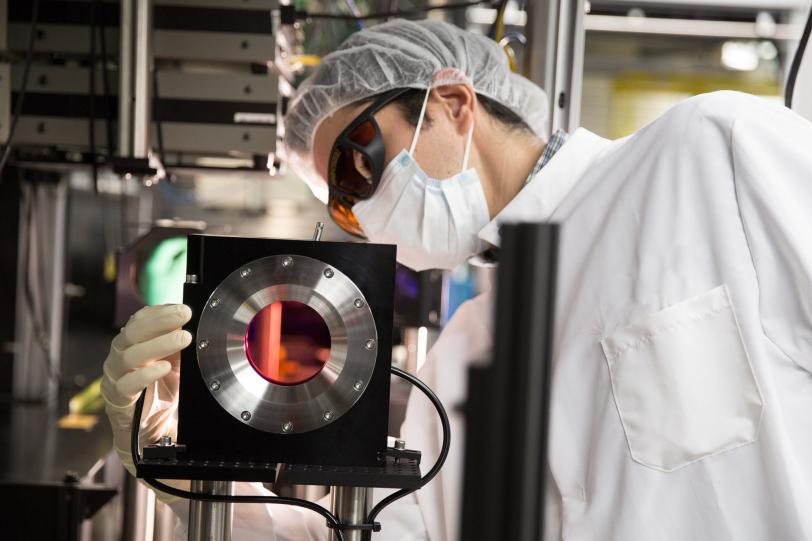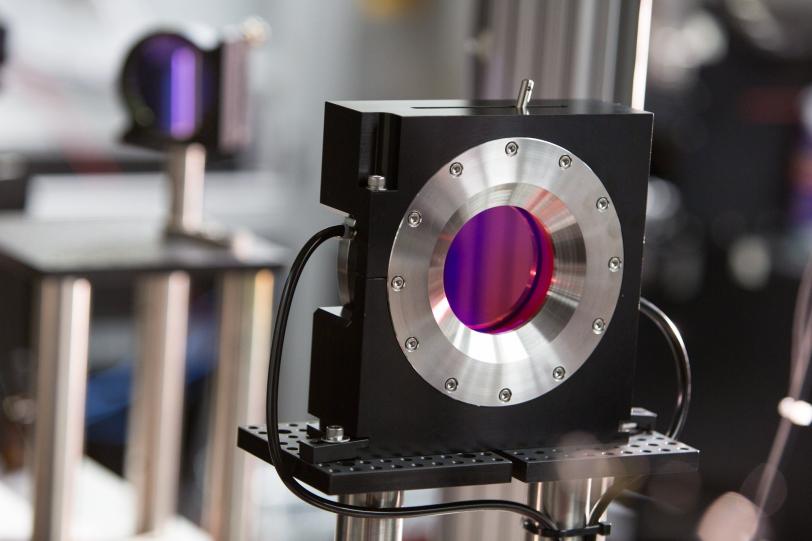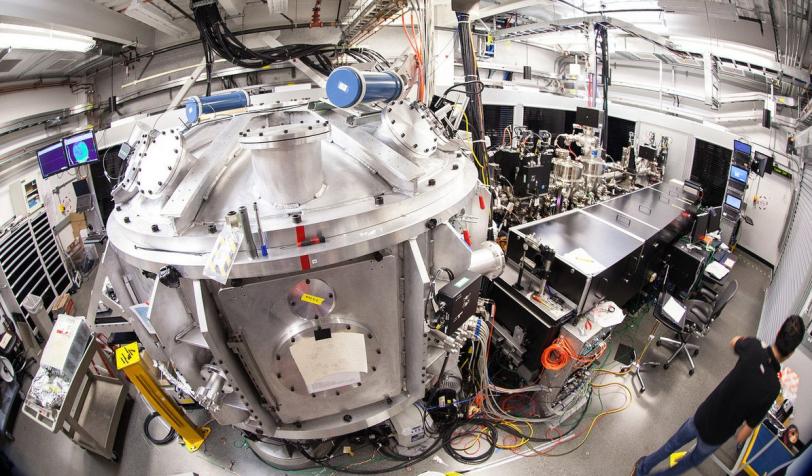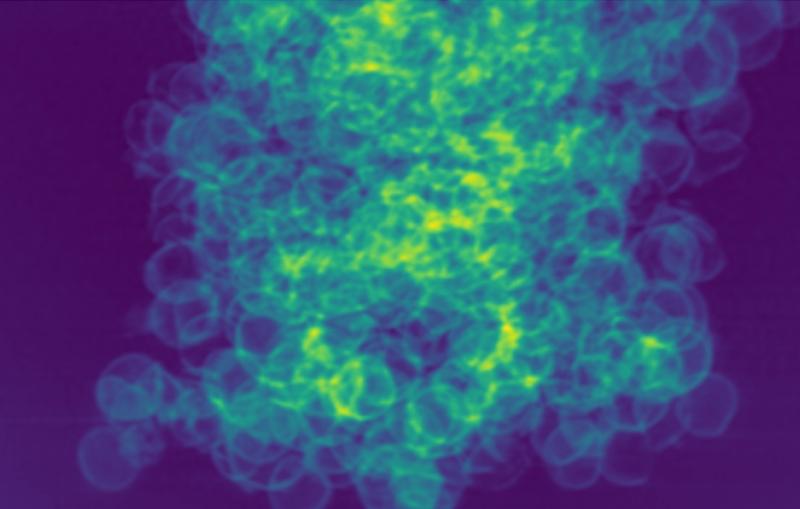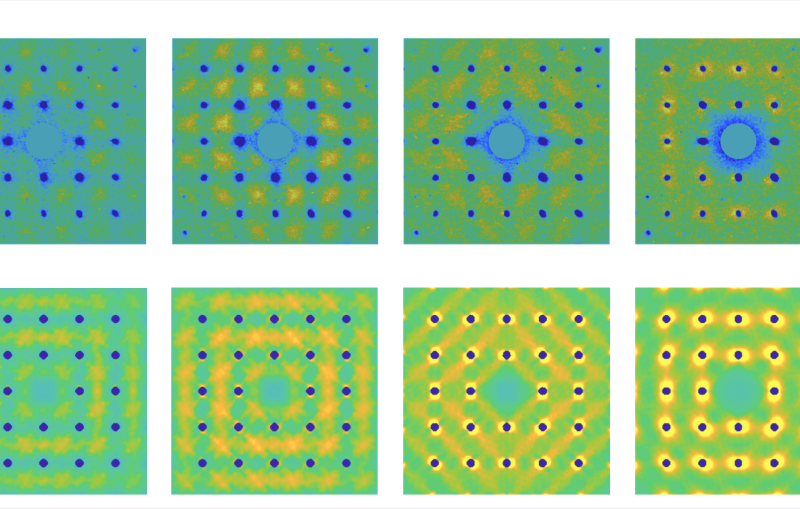200-terawatt Laser Brings New Extremes in Heat, Pressure to X-ray Experiments
High-power Laser Couples with SLAC's X-ray Laser to Reveal Atomic Detail as Matter Rapidly Transforms
A newly upgraded high-power laser at the Department of Energy’s SLAC National Accelerator Laboratory will blaze new trails across many fields of science by recreating the universe’s most extreme conditions, such as those at the heart of stars and planets, in a lab.
It is the first high-power laser system to be paired with SLAC's X-ray laser, the Linac Coherent Light Source (LCLS). LCLS can precisely measure extreme forms of matter created by the high-power pulses – with temperatures reaching millions of degrees and pressures approaching 2 billion tons per square inch, about 300 billion times the pressure at sea level – as it rapidly transforms at the atomic scale. The upgraded laser will be useful for studying how materials transform under stress and for understanding the physics of nuclear fusion, which could one day serve as a revolutionary source of energy.
Scientists can also use its pulses to drive a variety of particle beams that explore forms of matter, such as star-like dense plasmas, in new ways. Plasmas, which are considered a fourth state of matter because they are not like solids, liquids or gases, consist of a gassy soup of charged particles that includes free-floating electrons and the atoms the electrons were stripped away from.
“This will give us more insight into the processes at work, from the atomic to electronic states,” said Eduardo Granados, a laser scientist at SLAC who oversaw the upgrade.
The upgraded laser system is designed to reach a peak of 200 terawatts of power, seven times higher than its previous peak and equivalent to about 100 times the world’s total power consumption compressed into tens of “femtoseconds,” or quadrillionths of a second. Its peak power before the upgrade was 30 terawatts. The laser’s pulses are now far more powerful than the total combined pulse power of the more than 150 other laser systems in operation at SLAC.
New Ways to Probe Materials
Even though SLAC’s upgraded laser is not the most powerful in the world – a laser completed in Japan this year now holds the record, with roughly 10 times higher power, and many other laser systems around the globe are several times more powerful – what makes it unique is its ability to synchronize with the intense, ultrafast X-ray pulses produced at LCLS, a DOE Office of Science User Facility.
The growth in these high-power laser systems around the globe opens new avenues for discovery and has excited interest among researchers working in astrophysics, materials research, planetary sciences, geology, and nuclear and energy sciences, among other fields. On Sept. 30, an international symposium organized by the Science Council of Japan met at SLAC to discuss the latest developments in using high-power lasers and X-ray lasers to study matter at extreme conditions, and similar discussions are planned during a two-day High-Power Laser Workshop this week at SLAC and during an upcoming lab-based astrophysics conference at SLAC.
SLAC's high-power laser emits light pulses at invisible, near-infrared frequencies that push samples to extreme conditions; the X-ray laser then probes their properties with incredible precision. Both laser systems can produce pulses measured in femtoseconds, and the timing delay between the high-power and X-ray pulses can be adjusted to study how materials rapidly transform after they are hit by the high-power laser pulse.
The high-power laser can also be used to simultaneously generate beams of particles such as gamma rays, protons and a specialized form of X-rays called betatron radiation all of which can be used in concert with LCLS pulses to explore exotic states of matter in new ways.
"We will now have a much more accurate picture of what's happening in high-energy X-ray laser experiments," Granados said.
Opportunity for Future Upgrades
At the core of SLAC’s upgraded laser system, which is housed at the Matter in Extreme Conditions experimental station at LCLS, is a large, high-quality titanium-sapphire crystal, measuring more than 3 inches in diameter. The crystal stimulates and amplifies light from another laser. That amplified light is focused down to a spot just millionths of an inch across, and timing systems help to synch the arrival of each laser pulse with an LCLS X-ray laser pulse with a precision measured in femtoseconds.
The upgraded high-power laser at LCLS will be available to scientists during the next round of experiments at LCLS, which begins in October, at half of its designed peak power, 100 terawatts. The plan is to gradually ramp up its intensity over time toward regular operation at 200 terawatts, Granados said. The laser will initially be able to fire one pulse every 3.5 minutes at 100 terawatts, with a pulse length of about 40 femtoseconds. At its peak power of 200 terawatts, it will fire one shot every seven minutes.
Granados said the laser system can eventually be upgraded further, up to 300 terawatts and perhaps as high as 400 terawatts, with additional equipment.
Even before the upgrade the laser system was used for a first-of-a-kind LCLS experiment that used its pulse to produce a secondary surge of X-rays in the form of betatron X-rays. Those betatron X-rays, which cover a broader energy range than the LCLS pulses and were produced by accelerating high-energy electrons with laser light, were used to reveal more details about the samples.
"These betatron X-rays are a promising source for future experiments that we now want to test at higher energies," Granados said.
For questions or comments, contact the SLAC Office of Communications at communications@slac.stanford.edu.
SLAC is a multi-program laboratory exploring frontier questions in photon science, astrophysics, particle physics and accelerator research. Located in Menlo Park, Calif., SLAC is operated by Stanford University for the U.S. Department of Energy's Office of Science.
SLAC National Accelerator Laboratory is supported by the Office of Science of the U.S. Department of Energy. The Office of Science is the single largest supporter of basic research in the physical sciences in the United States, and is working to address some of the most pressing challenges of our time. For more information, please visit science.energy.gov.
